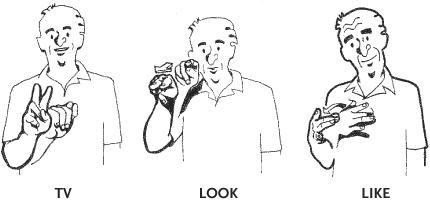The American Sign Language Phrase Book (14 page)
Read The American Sign Language Phrase Book Online
Authors: Lou Fant,Barbara Bernstein Fant,Betty Miller

2. Cause and Effect or Stimulus-Response Statements.
In real life, you cannot have an effect without first having a cause, or a response without first having a stimulus. I cannot, for example, scream before a safe falls out of the sky and lands a few feet from me. Neither could I yell "Ouch!" before stubbing my toe on a chair leg. The safe (the cause) must fall first, and the stubbing of my toe (the stimulus) must happen first. The cause/stimulus in these kinds of statements is the topic, the effect/response is the comment.
In the statement "I'm scared of thunder and lightning," the cause/stimulus is
thunder and lightning
, and the effect/response is
scared of
.

In the statement "I felt better after I took the medicine," the cause/stimulus is
took the medicine
, and the effect/response is
felt better
.

3. Statements That Require Real-Time Sequencing.
"Real-time sequencing" means that the events in a statement must be arranged in the chronological order in which they occurred in real life, another way of saying that the cause/stimulus must come before the effect/response.
In the statement "I was happy that no one was hurt when the plane landed safely," the events are not in chronological order. Rearranged to conform to real-time sequencing, the statement reads, "When the plane landed safely and no one was hurt, I was happy." Picture the scene in your mind as if you were watching it happen.
First you see the plane land, then you see everyone get out and that no one is hurt, and then you feel happy.

4. Statements That Move from General to Specific.
These statements require that you visualize the whole scene, just as you did with the airplane, but this time you move from the large to the small. An example is "There's an old man in the white house on that farm."
First see the whole picture of a farm with a white house on it; then move in closer to see an old man in the house.

Another example is "I was exhausted by the time I arrived at the hotel in New York." Start with the largest thing, "New York"; then work down to the next largest thing, "hotel." The next largest thing after "hotel" is "I." See yourself arriving at the hotel and then feeling exhausted.

Your success in putting the signs in the correct order, as you probably can tell by now, lies in your ability to imagine, to visualize a scene. ASL is, after all, a visual language, so you must develop this skill.
Pronoun signs tend to come before verbs, at the end of statements, and often in both positions. As a rule, they tend to appear at the end of a statement more often than at the beginning, but this rule is honored as much in the breaking as in the keeping of it. As a result, you will not be wrong if you put it in either or both places.
All the pronouns may be expressed by just three hand shapes. The first group is made up of the pointing pronouns. Simply point to get:
I
,
me
,
you
,
he
,
she
,
him
,
her
,
it
.
The second group is the possessive pronouns:

The third group is the self pronouns:

Third person plural pronouns move in a very small arc:

First and second person singular pointing pronouns tend to come at the end of a statement:

Sometimes the first and second person singular point pronoun is dropped entirely, especially in questions:

